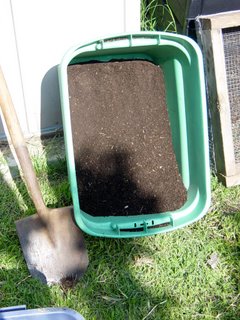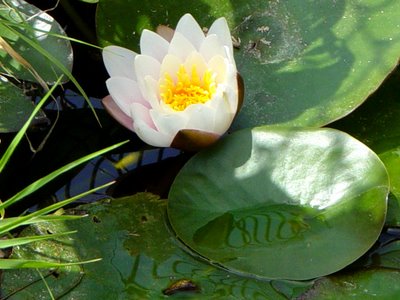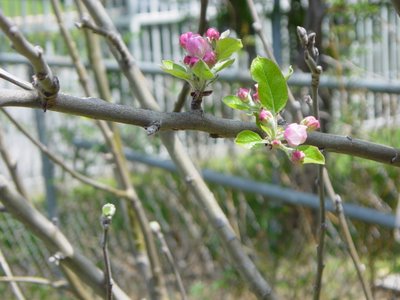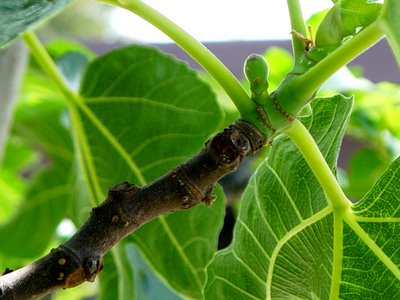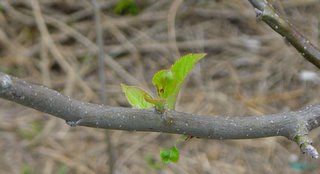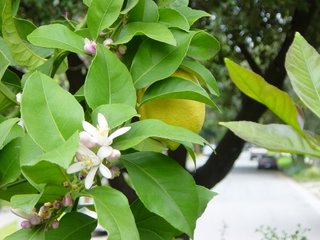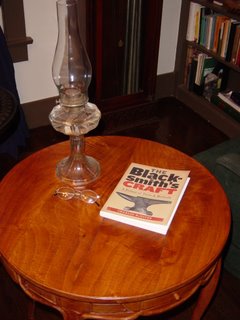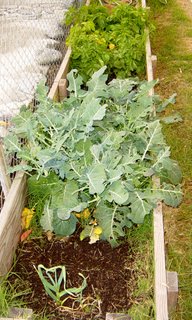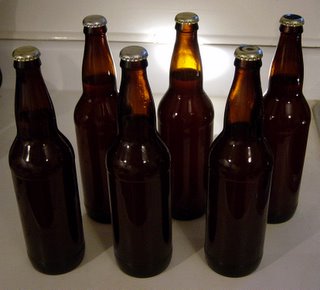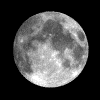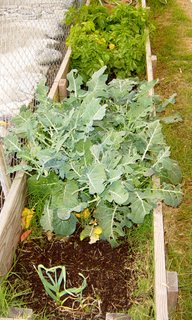 The Garden is in an odd state; the blazing summer has given way to cold and hot weather all at the same time. Three weeks ago it was 90 degrees in Pasadena, a few days later the morning dawned at 29 degrees in the back yard.
The Garden is in an odd state; the blazing summer has given way to cold and hot weather all at the same time. Three weeks ago it was 90 degrees in Pasadena, a few days later the morning dawned at 29 degrees in the back yard.Pumpkins produced a nice small crop, some of which have gone to the worm bin, the last two of which await metamorphosis into pie. Squash never produced much, apparently taken over by the pumpkins. Pickling Cucumbers produced nicely, but I did not hit on a pickle recipe that I
 really liked. A small patch of corn did well enough. Several volunteer sunflowers provided a visually interesting element. (Fed the seeds to the birds this year, though. )
really liked. A small patch of corn did well enough. Several volunteer sunflowers provided a visually interesting element. (Fed the seeds to the birds this year, though. ) Bell Peppers that nearly croaked over the super hot summer and produced nothing have bounced back during the cool-but-not-cold fall and are producing abundantly; allowed to go red, the bells are nearly apple sweet, and I have been slicing and freezing peppers for stir fry later. Here is today's haul with this many more ready any day and more still just developing.
 Oak Leaf lettuce and spinach are in the raised bed, and doing well. The greens came from nursery starts, not seed, since I can't seem to get greens to make it much past germination without providing a meal for whatever pests we happen to have hereabouts. Now that the starts worked, we need a greater variety of greens, which I will try to put in over break. And we could use some other winter crops -- some garlic and onions, some brocolli, maybe even some cabbage, but haven't had the chance to put 'em in the ground.
Oak Leaf lettuce and spinach are in the raised bed, and doing well. The greens came from nursery starts, not seed, since I can't seem to get greens to make it much past germination without providing a meal for whatever pests we happen to have hereabouts. Now that the starts worked, we need a greater variety of greens, which I will try to put in over break. And we could use some other winter crops -- some garlic and onions, some brocolli, maybe even some cabbage, but haven't had the chance to put 'em in the ground.
 Oak Leaf lettuce and spinach are in the raised bed, and doing well. The greens came from nursery starts, not seed, since I can't seem to get greens to make it much past germination without providing a meal for whatever pests we happen to have hereabouts. Now that the starts worked, we need a greater variety of greens, which I will try to put in over break. And we could use some other winter crops -- some garlic and onions, some brocolli, maybe even some cabbage, but haven't had the chance to put 'em in the ground.
Oak Leaf lettuce and spinach are in the raised bed, and doing well. The greens came from nursery starts, not seed, since I can't seem to get greens to make it much past germination without providing a meal for whatever pests we happen to have hereabouts. Now that the starts worked, we need a greater variety of greens, which I will try to put in over break. And we could use some other winter crops -- some garlic and onions, some brocolli, maybe even some cabbage, but haven't had the chance to put 'em in the ground. Cauliflower -- also from starts -- is the new weird crop this year. Although they have been in the ground for awhile they seem stunted, and are growing slowly. Haven't taken the time to figure our why yet. A couple of the same plants in a terra cotta pot are triple in size.
The front yard potato patch is growing great guns, and I am inspired to de-grass another sector by spring for it.  We have purple, red and golden potatoes in the ground. Bought a bag at the store for seed (Trader Joe's, so no anti-sprout chemicals or GMO.)
We have purple, red and golden potatoes in the ground. Bought a bag at the store for seed (Trader Joe's, so no anti-sprout chemicals or GMO.)
 We have purple, red and golden potatoes in the ground. Bought a bag at the store for seed (Trader Joe's, so no anti-sprout chemicals or GMO.)
We have purple, red and golden potatoes in the ground. Bought a bag at the store for seed (Trader Joe's, so no anti-sprout chemicals or GMO.) The patch looks a little rangy at the moment, but the big growth and light soil here mean we should get a pretty good result. Nothing quite like just-dug potatoes, looking forward to 'em come February or March.
Why potatoes? They take a lot of abuse and produce nicely, for starters. But also, since they are planted along the public sidewalk it seemed a good idea to plant something without obvious appeal for vandals or the light fingered. (I.e., a pumpkin patch might not do best here; potatoes keep the good stuff hidden.)
Time to wrap up the week for winter break; time to figure out what is going into the ground come late February for summer early summer. Standby!




